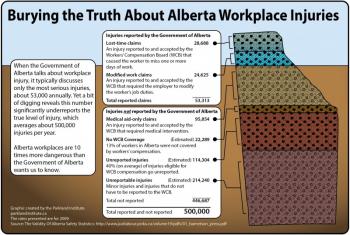This is an archive of news stories and research from the National Union of Public and General Employees. Please see our new site - https://nupge.ca - for the most current information.
Alberta government continues to understate the level of workplace injuries.
 Edmonton (01 Oct. 2013) -A new fact sheet released today by the Parkland Institute highlights the true rates of workplace injury in Alberta, and demonstrates how unions protect workers both from unsafe workplaces and a government keen to downplay the risks.
Edmonton (01 Oct. 2013) -A new fact sheet released today by the Parkland Institute highlights the true rates of workplace injury in Alberta, and demonstrates how unions protect workers both from unsafe workplaces and a government keen to downplay the risks.
Unions protect workers from unsafe workplaces
The fact sheet, written by Athabasca University professor Bob Barnetson, is titled Making it home: Alberta workplace injuries and the union safety dividend. It calculates that, although the Alberta Government only talks about injuries that resulted in lost or modified work (some 53,000 in 2009), the total number of workplace injuries annually in Alberta is actually about ten times that number.
“The reason for the discrepancy,” says Barnetson, “is that the only injuries the government discusses in public are the disabling injury claims. By not reporting on those injuries which do not result in lost or modified work, they are under representing the true rate of injury by a factor of ten.”
In October the Alberta government will begin issuing fines to enforce occupational health and safety, but Barnetson says that is not likely to make a significant difference to the total rates of injury in the province.
Alberta does not mandate joint worker-employer health and safety committes - unions negotiate worker participation which reduces injuries
The fact sheet highlights that what truly makes a difference in reducing injury rates is direct worker participation in cccupational health and safety efforts. This is one of the reasons that unionization provides workers with a significant safety dividend, especially in Alberta, the only jurisdiction in Canada where joint (worker-employer) health and safety committees (JHSCs) are not mandatory for any size of workplace.
In addition to unionized workers being much more likely to have access to a JHSC, the fact sheet highlights other ways in which unions result in increased safety:
- in Alberta unions support workplace safety education for all workers
- having a union in place increases the odds that a worker will feel they can refuse unsafe work
- unions provide experienced staff to represent workers at workers’ compensation hearings
- unions have a voice (often the only voice) at the table with government and can lobby for changes in legislation and participate in consultations and
- Alberta unions have been at the forefront of pushing for greater statistical reporting of injuries, making it difficult for the government to continue downplaying the workplace risks.
“We are not trying to imply that unionization is the only way to improve workplace safety,” says Barnetson, “but the data certainly shows that unions provide a significant safety dividend that benefits all Alberta workers.”
The Parkland Institute is a non-partisan public policy research institute in the Faculty of Arts at the University of Alberta.
More information:
Parkland Institute: Making it home
NUPGE
The National Union of Public and General Employees (NUPGE) is one of Canada's largest labour organizations with over 340,000 members. Our mission is to improve the lives of working families and to build a stronger Canada by ensuring our common wealth is used for the common good. NUPGE
